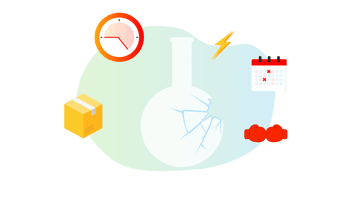The key to creating a positive lab culture starts with the onboarding process and bringing together a collaborative, high performing group with shared goals. High performing teams have a shared commitment to the team’s mission, communicate frequently and openly, have mutual accountability, and come from diverse backgrounds.
Beyond talent sourcing and onboarding, retention is crucial as well and is driven by the lab culture and environment. The core strength of your lab resides in the qualifications and successes of your employees.
Once you have completed the necessary rounds of interviews, extended job offers to your top candidates, and those talented individuals have accepted your offer, it is time to begin the onboarding process.
Oftentimes the first 30 days of an employee’s experience with your organization can make or break that worker’s experience at your company.
To pull off a successful onboarding process that leads to long term retention for your new talented hires:
- Introduce all new hires to one another in a casual setting so they can begin building their camaraderie outside of a working situation.
- Assign the new employees an experienced worker to guide them around on their first few days and act as a mentor for day to day questions and collaboration—someone who can show them all the basics like where the bathroom and kitchen are, someone who they can eat lunch with, and someone who they can feel comfortable asking any question that pops into their head to.
- As much as possible, spread out the more tedious parts of the onboarding process so there aren’t any hours long chunks of time that employees spend just filling out paperwork. (There are lots of online apps and tools like DocuSign that allow new staff to complete onboarding paperwork on their own time more efficiently.)
- Set up one on one meetings for new hires to familiarize themselves with the core staff that they will be working with the most, including heads of other departments or teams so new hires can get a comprehensive view of the company.
- Highlight leadership and growth opportunities for new hires.
Employee churn is to be expected, and is often a sign of a healthy industry. However, retaining top lab staff is always a goal that lab managers should strive for. In order to retain your staff, you first need to develop a clear understanding of why they are leaving your organization or similar lab environments to work elsewhere.
The most common reasons that lab staff leave their positions is that they found higher salaries elsewhere, they are seeking better benefits, they are disengaged in their current role, or they are looking for opportunities for career growth that they cannot find at your company. To gain an understanding of why staff is leaving your organization, conduct an honest exit survey process with those leaving and then use the information you gain from their exit interview in your strategy to retain current employees.
Retain your current and future lab staff by:
- Tracking how your highest performing team members found the role and targeting recruiting efforts at those channels
- Setting clear, long-term expectations for your new hires
- Providing your highest performing lab staff opportunities for advancement so they continuously feel valued
- Including job benefits outside of pay and time off, like an increase in recognition for work accomplishments and opportunity for skill development
- Ensuring that your lab is a welcoming and encouraging place to work for all staff
- Avoiding micromanaging your employees by training them well and then giving them space to succeed
- Being open to- feedback from your employees using an “open door policy” and actually incorporating the feedback they provide where relevant
Fostering a strong team-based atmosphere is an essential part of every high-performing lab environment. In order for your lab to thrive, all of your employees must value the work of their coworkers and understand how everyone’s efforts contribute to the overall goals of the lab.
Team building should be an everyday activity, not some quarterly mandatory off-site function.
To introduce daily team building to your lab staff, start by:
- Letting your staff know that they are a team and you will reward their successes based on team performance
- Reinforce the belief that your staff is a team by encouraging them to hold team meetings independently and by tracking team goals
- Show your staff that the team is capable of achieving more than each individual by clearly delineating milestones they can only achieve through teamwork
- Continuously challenge your teams with higher and higher goals, then celebrate their collaborative successes and point out how each individual achievement played a part in the broader goal
- Occasionally enforcing larger team building exercises outside of the office—just remember to consult your team members first to decide on an appropriate outing so you don’t end up creating a mandatory happy hour bowling event for a team comprised of sober golfers
- Leverage virtual team building exercises
- Facilitate regular non-work related check ins for staff to get to know one another better
- Hold daily or weekly stand ups so all staff are aware of other team members’ goals, progress, and roadblocks
It is your responsibility to not only define your staff’s understanding of what professional growth looks like at your organization, but to also present them with opportunities for professional development. As mentioned before, when they can clearly see opportunities for career advancement or general learning, your employees will be far less likely to jump ship and look to grow their career elsewhere.
Professional development opportunities are often a combination of internal training initiatives and external workshops or consultations. To cultivate an environment of growth in your lab, begin by focusing on the internal training initiatives that you offer your staff.
Create a successful laboratory training program by:
- Determining training needs by researching industry skills needed stay competitive in your market
- Analyzing your current staff skills in order to determine where there are gaps
- Perform this gap-analysis with individual staff members by discussing where they are now and where they would like to be, then work together with individual staff members to create a skill development strategy
- Involving both immediate superiors and senior management into the training program to ensure the goals of the program align with larger organizational goals
- Communicating clearly with staff so they understand why they are taking a specific training program—without selling employees on the specific purpose of their training you run the risk of them failing the program due to perceived irrelevance
- Preparing a training project management plan that breaks down the structure and costs of the training, then you can determine if it is a better bet to outsource that specific training to an external workshop or consultation
A good, team-based work environment is necessary when it comes to fostering and maintaining a high-functioning lab.
Tangible steps toward creating a positive lab culture include:
- Listening to your staff and including them in both research and facilities-related meetings so they always know their voices are heard
- Including staff in research meetings so they can always see exactly how their actions affect the larger goals of the organization
- Keeping a pulse on your staff, whether you’re leading in-person or leading virtually
- Setting clear lab etiquette expectations from the start that includes the upkeep of everything from lab equipment to the staff break room
- Focusing on constant team building by regularly emphasizing cooperation and open communication
- Maintaining a welcome and supportive atmosphere for not only permanent full-time staff, but also all visitors, vendors, suppliers, part-time workers, research assistants, and student trainees
- Reigning in negativity by keeping an eye on any atypical employee behavior and approaching staff experiencing complicated feelings with empathy in order to overcome potential camaraderie or motivation roadblocks
- Creating a specific time and place for staff feedback
From the beginning of the onboarding process through the celebration of employee milestones, the culture at your lab is constantly evolving. To keep your lab an inclusive environment that fosters creativity and innovation at every turn, continue to motivate your staff with these tactical steps in mind.




